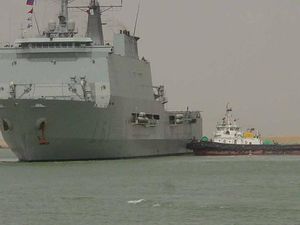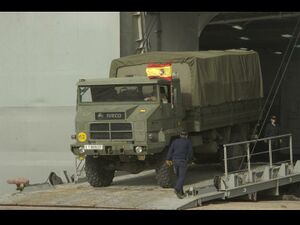Enforcer-class: Difference between revisions
Jump to navigation
Jump to search
imported>Howard C. Berkowitz No edit summary |
mNo edit summary |
||
| (2 intermediate revisions by 2 users not shown) | |||
| Line 1: | Line 1: | ||
{{PropDel}}<br><br> | |||
{{subpages}} | {{subpages}} | ||
[[Image:Galicia deliving humanitarian supplies to Iraq.jpg|thumb|Galicia deliving humanitarian supplies to Iraq.]] | [[Image:Galicia deliving humanitarian supplies to Iraq.jpg|thumb|Galicia deliving humanitarian supplies to Iraq.]] | ||
| Line 94: | Line 95: | ||
==References== | ==References== | ||
<references/> | <references/>[[Category:Suggestion Bot Tag]] | ||
Latest revision as of 11:00, 12 August 2024
| This article may be deleted soon. | ||||||||||||||||||||||||||||||
|---|---|---|---|---|---|---|---|---|---|---|---|---|---|---|---|---|---|---|---|---|---|---|---|---|---|---|---|---|---|---|
The joint Spain/Netherlands Rotterdam/Galicia class of Landing Platform Dock naval vessels for amphibious warfare are called the Enforcer class for export.[1][2][3][4][5] These vessels are designed to carry a battalion of troops and land them, and their vehicles. The vessels have a flight deck and hangar, for deploying helicopters, and a well deck for deploying landing craft. Both Spain and the Netherlands built two vessels of this class.[1][2] The original design was a Netherlands design.[5] Spain and the Netherlands signed a Memorandum of Understanding in June 1992 to jointly develop this class of vessels. Specifications
References
|
||||||||||||||||||||||||||||||

